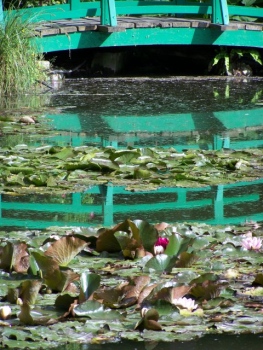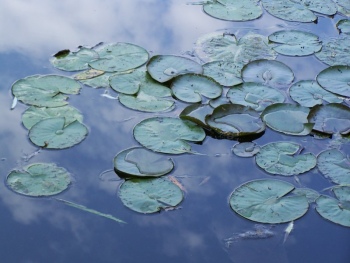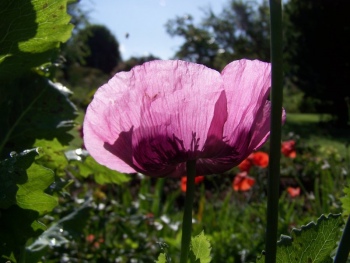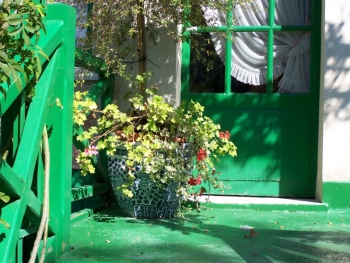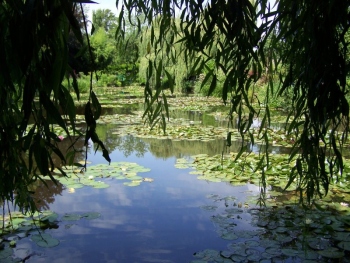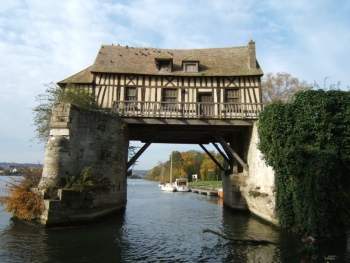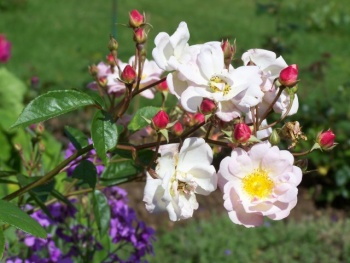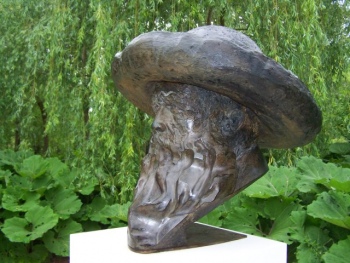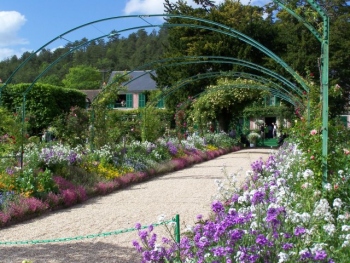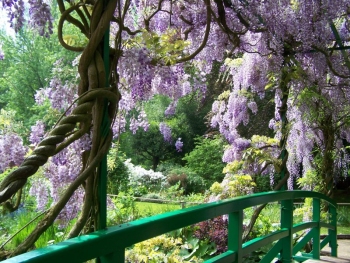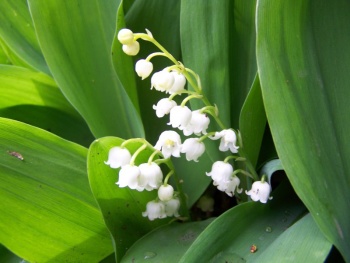June 11, 2008
Claude Monet was influenced by his extensive collection of Japanese woodblocks when he created his water garden.
He liked all the bamboos, wisterias, water lilies or peonies he could see on them and wanted these exotic plants in his garden.
He also loved the curved bridges which are so common on Japanese prints.
But although Monet knew pretty well the lay out of a Japanese garden thanks to his readings and to his neighbour American painter Lilla Cabbott Perry who had lived in Tokyo, he took poetic license.
He didn’t intend to create a true Japanese garden. His bridges are much less bent than authentic ones, and they are green. In a true Japanese garden, they should be red.
Posted in Water-Garden 1 Comment »
June 10, 2008
Water lilies have their own dreams: being as light as soap bubbles and float in the air…
Monet was fascinated by the reflection of the sky and the clouds.
When the water is absolutely still the surface of his lake is a perfect mirror.
The Nympheas seem to hang in the blue sky.
Posted in Water-Garden No Comments »
June 9, 2008
Claude Monet liked poppies, red poppies in the fields and pink poppies in his garden at Giverny.
His painting of his wife and son walking in a meadow full of poppies is one of the most famous of musée d’Orsay in Paris.
All the poppies are currently in bloom in his flower garden at Giverny, tiny or enormous, scarlet or pink, orange, yellow, some one color, some two. The pink and purple poppies are spectacular.
Monet preferred one color flowers but he also used two color flowers just as he could take two colors with his brush on his palette and put them in one gesture on the canvas.
Posted in Flower No Comments »
June 8, 2008
Monet’s home in Giverny has three entrances, each one dedicated to a particular use.
This is typical for the time when the house was built, in the 19th century.
One door was devoted to Monet’s own use. It leads directly to his first studio and to the stairs to his bedroom. It enabled Monet to go in and out without disturbing the family life – he liked to get up exceedingly early in the morning – or perhaps without being disturbed by the family life – there were eight children in the family. This entrance could be called the professional one.
There was of course a main entrance for family members and guests.
The third one was a domestic entrance leading directly to the kitchen.
Posted in Monet's House No Comments »
June 6, 2008
Monet’s garden at Giverny is full of roses.
It is not a proper rose garden, for there are also many other sorts of flowers, but nonetheless it is gorgeous in May and June when the roses are in bloom.
They are everywhere, weeping from the umbrella like structures, climbing on trellises, on fences, on trees, on the facade of the house, wrapped around tripods, in bunches, or among peonies and sweet rocket in the mixed borders…
All sorts of colors can be seen, pale cream, pure white, soft yellow, many pinks, red, orange… Not all of them are simple roses but many are scented. Light and delight.
Posted in Monet's flower garden 4 Comments »
June 5, 2008
Monet was keen on painting through the weeping willow. It was difficult, and he liked the challenge.
There was the vertical axis of the branches and the horizontal axis of the floating water lilies.
In addition, the reflection of the sky looks like a hole in the water.
And Monet could even see the stems of the flowers under the surface.
When he painted here, he had to mix all the different plans to put them on the two dimensional canvas.
Posted in Water-Garden No Comments »
June 4, 2008
This bizarre house overhanging the Seine river in Vernon, 5 km from Giverny, surprises and puzzles many visitors.
It seems so strange that somebody had the idea of building it this way!
No wonder when you know that it once was a mill. The wheel doesn’t exist anymore. In the Middle Ages mills were currently built on bridges.
Monet was inspired by this old house. He painted it from his studio boat. The painting is now in the museum of Fine Arts in New Orleans.
Posted in Vernon 3 Comments »
June 2, 2008
Claude Monet preferred simple roses, with one row of petals instead of more complicated double roses.
Double flowers with many petals seemed too sophisticated for his garden located 80 km from Paris in the small village of Giverny, in the middle of the countryside.
Simple roses look like the wild ones which are currently in bloom in the fields.
In the same range of ideas Monet didn’t consider all the wild flowers like weed. He accepted many of them among the cultivated ones. They give sort of a countryside touch to his flower garden.
Posted in Monet's flower garden No Comments »
May 30, 2008
A bust of Claude Monet by the sculptor Daniel Goupil can be admired in Giverny.
Surprisingly enough, the tribute to the master of Impressionism is not exhibited on a well exposed location, in front of his home for instance. On the contrary you have to look for it to find it.
The artist wanted Monet to face the landscape he loved, the meadows and the poplars of the Seine valley.
The bust is situated on the very spot where Monet painted several canvases.
It is to be found on the back of the main parking lot ‘La Prairie’, slightly hidden by a big weping willow.
Posted in Giverny No Comments »
May 23, 2008
Monet’s flower garden is divided by a broad alley.
He designed the whole garden except this walk which existed when he settled into the house.
When they came to Giverny this alley was lined by spruce trees. It was dark and full of shade, what pleased Alice: she could walk out in the garden without a parasol. But Monet disliked the spruce trees because flowers would not grow in their shade.
The couple had many arguements about these trees, and it is obvious who won.
Did Alice give up, as a smart lady? Monet kept the two yew trees at the top of the way, and he cut the other ones at a four meter height. The trunks looked like columns. Monet grew climbing roses on them and between each pair of columns he had arches also with climbing roses.
The result was lovely in spring. Now, only the arches and the yew trees remain.
Posted in Monet's flower garden No Comments »
May 21, 2008
Monet was 42 when he arrived in Giverny.
Let’s say he was in his forty-third year, and he spent forty three years in Giverny. Exactly half of his life!
When he arrived he was looking for a big house to live with his family. He was lucky enough to find this one.
He felt so happy there he never wanted to move anymore.
Posted in Monet's House No Comments »
May 14, 2008
The wisteria is at its peak over the Japanese Bridge in Claude Monet’s garden.
Its flowers look like long grapes. They are a soft tone of lavender and produce a delicious scent which recalls to the scent of jasmine.
It is an incredible feeling to stand on the bridge and be surrounded by the blooming wisteria all around you.
The beautiful effect doesn’t last very long, but Monet had thought of a special jocker. A second later wisteria will follow the lavender one when it is over. The second one is a white wisteria.
Posted in Water-Garden 1 Comment »
May 7, 2008
This part of Monet’s water garden at Giverny ‘looks like Japan’, as the painter would have said.
Monet was inspired by his large collection of Japanese woodblocks when he landscaped his water garden. He planted many exotic species of plants he could see on the prints, like azaleas, rhododendrums, wisterias, bamboos, Japanese maples and of course water lilies. Monet imported peonies in trees from Japan. Many plants in his garden had never been seen before in Giverny.
However his garden is not a true Japanese garden, the spirit being very different.
Posted in Water-Garden 1 Comment »
May 1, 2008
Just in time for May 1st, the lily of the valley is blooming in Monet’s water garden at Giverny. It is a shy flower that likes to hide but its scent betrays it.
In France the tradition is to give a sprig of lily of the valley on May 1st to the ones you love to bring them luck.
Here is my sprig for you, be lucky all year round!
Posted in Flower No Comments »
April 27, 2008
Spring has come suddenly. It was warm and sunny today, and the sunshine enhanced the bright colors of Monet’s flower garden.
In the water garden the azaleas are in full bloom. On the trees the little leaves look tender and fresh.
April light has a special quality, a sort of sparkling effect that can be noticed on Monet’s footbridge seen into backlight.
Posted in Water-Garden 1 Comment »
